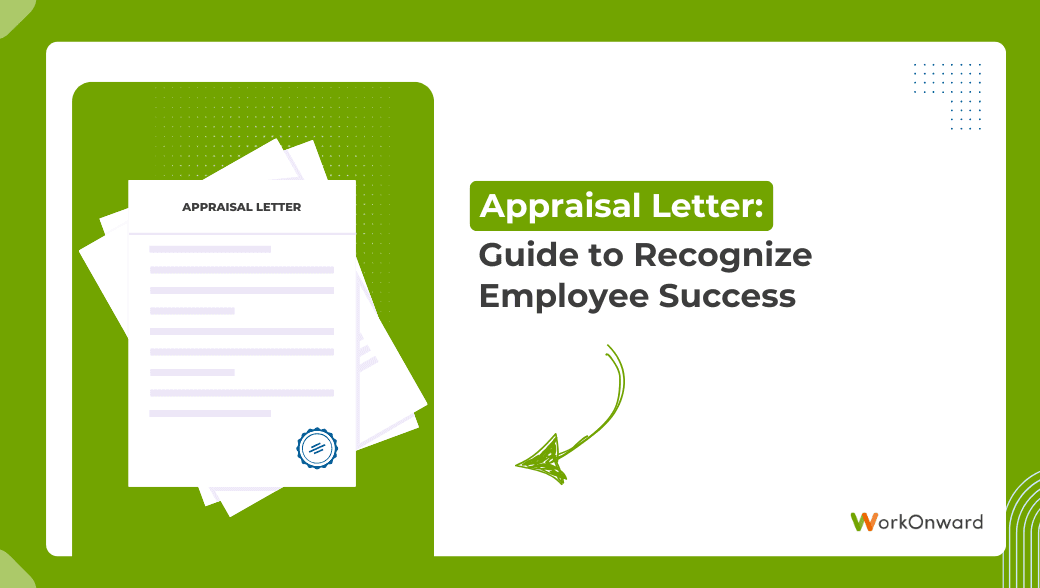Probably one of the effective tools for transmitting recognition, feedback, and motivational messages in any professional setting would be employee appraisal letters. Indeed, these would represent documents that recognized an individual's inputs within the organization as well as would align their goal post with the organizational future aspirations.
In this extensive guide, we will explore the importance of appraisal letters, what constitutes their basic elements, and how they can be a key driver of organizational success. In the process, we will identify how WorkOnward, a pioneering recruitment and HR platform, streamlines the appraisal process for small, medium, and large-scale companies.
What is an Appraisal Letter?
An appraisal letter is a formal communication issued by an employer to let an employee know his or her performance review and feedback. It is usually composed of the feedback on the employee's work done within a period, which includes great achievements and changes in role, duties, or compensation.
The major reasons for the appraisal letter are:
Provide recognition for the employee’s contributions.
To acknowledge the employee's contribution.
Offering constructive criticism to improve the future performance.
Motivate the employee by the benefits or promotion.
Link personal performance to the organizational goals.
Why Are Appraisal Letters Important?
1. Motivation for the Employee
An appraisal letter is a document that serves as a tangible reward for an employee's hard work. Recognition motivates, increases morale, and promotes productivity.
2. Performance Appraisal
This letter gives the employees clear feedback about their areas of strength and weaknesses.
3. Transparency
A well-structured appraisal letter shows that the organization is dedicated to fairness and transparency in awarding its workers.
4. Retention Plan
Acknowledging and rewarding employees strengthens their sense of belonging, reducing turnover rates.
Key Components of an Appraisal Letter
A professional appraisal letter includes the following elements:
1. Employee Details
Name
Designation
Department
2. Purpose of the Letter
Clearly state the reason for the appraisal, such as an annual review or outstanding project performance.
3. Performance Overview
Summarize the employee's achievements, contributions, and overall performance during the review period.
4. Constructive Feedback
Provide actionable suggestions to enhance future performance.
5. Recognition and Rewards
Mention any promotions, salary hikes, bonuses, or additional perks awarded to the employee.
6. Future Expectations
Set goals for the next review period, aligning them with organizational objectives.
7. Closing Statement
Remind the employee to keep up the good work and offer support for growth.
8. Authorized Signatory
Include the name, designation, and signature of the approving manager or HR representative.
Sample Appraisal Letter

How WorkOnward Improves the Appraisal Process
WorkOnward believes in equipping organizations to build a culture of recognition and growth. The appraisal process is streamlined with the following features on our platform:
1. Automated Appraisal Cycles
Schedule and track appraisal cycles effortlessly to ensure timely reviews.
2. Centralized Feedback Collection
Collect 360-degree feedback from peers, managers, and subordinates to create a holistic performance evaluation.
3. Customizable Appraisal Letter Templates
Available time is saved by using ready-to-use templates, which can be customized according to your organization's needs.
4. Employee Performance Analytics
You receive detailed reports and insights for informed appraisal decisions.
5. Integration with HR Tools
Integrate directly with your current HR systems to facilitate smooth workflow.
Spend some quality time to sign up with WorkOnward today.
Writing an Appraisal Letter
1. Be Specific
Go ahead and refrain from using generic phrases. Write down all the specific achievements and areas of development.
2. Maintain a Positive Tone
Even when giving constructive criticism, make sure the tone is encouraging and supportive.
3. Personalize the Letter
Talk about the employee's specific contributions and make them feel valued.
4. Use Professional Language
Make sure the letter is clear and professional.
5. Focus on Growth
Talk about future opportunities and development to inspire employees.
Conclusion
An appraisal letter is more than just a formal document; it is a bridge between an employee's efforts and the organization's recognition. Through the acknowledgment of accomplishments, constructive feedback, and future goals, appraisal letters lay the foundation for mutual growth and success.
With WorkOnward's innovative HR solutions, organizations can streamline their appraisal processes, foster a culture of motivation and excellence, and be ready to revolutionize your HR operations. Sign up for WorkOnward and unlock the future of employee management today.







